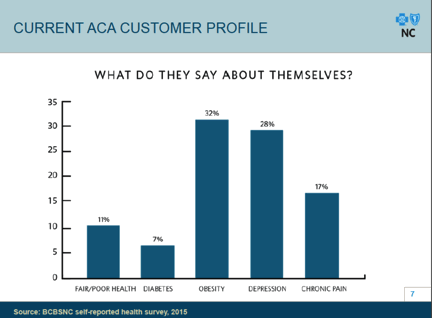It’s rate-filing season for health insurance companies, and last week marked the deadline for carriers to disclose and explain any proposed rate increases of 10 percent or more for 2016 Obamacare plans sold on the individual market. Blue Cross and Blue Shield of North Carolina made the cut.
As the state’s dominant insurer awaits approval from the N.C. Department of Insurance for its proposed 26 percent average premium hikes, vice president and chief actuary Patrick Getzen explained the rationale in a media briefing.
In sum, claims data from January through March of this year indicate that 2015 individual market policyholders skew older and sicker compared to 2014 customers. Self-reported data from policyholders below correlates to increases in hospital admissions, imaging services, emergency department usage, chronic health conditions, and specialty medications.

Now that insurers must accept any applicant, regardless of health status, premium increases are not all that surprising. But 25 percent?
Getzen threw out an example to put the underlying rate increase in perspective: a 40-year-old man with a Blue Value Silver Plan may now be paying $315 per month for a plan with a $2,500 deductible. Next year, however, that person could be ponying up $391 per month with the same deductible.
Despite the fact that 94 percent of BCBS enrollees do qualify for premium or cost-sharing assistance, plans are still pricey. It’s clear that low-income individuals benefit the most from subsidies, but on Obamacare’s sliding scale those greatly tail off once income hits 250 percent of the federal poverty level, which translates to around $29,000 for an individual and $60,000 for a family of four.
As a result, the insurer is seeing a trend in which one in five customers has signed up for coverage, paid the first month’s premium, used services, and then dropped his plan. So, of the 397,000 second-round BCBS exchange enrollees thus far, the net figure really equates to around 317,600.
The individual market could very well remain on precarious footing over the next couple of years. Since the Obama administration urged insurers to extend pre-Affordable Care Aact plans until 2017, the anticipated and actual Obamacare risk pools for 2014 didn’t quite match up.
Many policyholders — especially the young and healthy — decided to hold onto these plans, creating a higher-risk 2014 enrollment mix.

That first blow to insurers triggered Blue Cross to suffer its first financial loss in over 15 years — a total revenue decline of $60 million.
The fact that the federal health law enforces tighter community rating ratios doesn’t help one iota, either. Inflated premiums for the young and healthy to offset the medical costs incurred by the old and sick does not attract young and healthy customers — the very population needed to maintain a balanced pool.
And then there are the three “R’s” built into Obamacare that sought to mitigate initial market instability for insurers participating in Obamacare’s individual marketplace:
Risk adjustment operates as a give and take among insurers. Those with higher-risk pools will be relieved with funds from insurers with lower-risk pools. Risk Corridors operate where funds are shifted from plans with lower-than-expected claims to offset other plans where actual payments have surpassed projected amounts. Reinsurance, commonly known as the “belly button tax,” acts as an insurance company’s own insurance policy, in which a fee is assessed on each person, including dependents, covered by most employer-sponsored health insurance. The fund will total over $20 billion up to 2017, and insurers can dip into this fund and be reimbursed 80 percent of a consumer’s annual claims that exceed $45,000. Both the risk corridors and belly button tax are set to expire by 2017.
With policyholders already facing an average 25 percent premium increase, recently introduced bills that call for more coverage mandates come at a particularly bad time. It’s important to note that a majority of the state’s insured population — those whose employers self-insure or who are covered under government programs like Medicare or Medicaid — are exempt from additional state-regulated health benefits. Therefore, any further mandates will leave the remaining nongroup policyholders and those on employer-purchased plans feeling an even deeper burn in their pockets.
Lastly, the anticipation of a favorable ruling for the plaintiffs in King v. Burwell cannot be left out of the health policy conversation. If the Supreme Court deems subsidies illegal in states with no state-run health insurance exchange, insurers and policyholders will be thrown for another loop.
It would then be wise for Congress to exempt individuals from the individual mandate and the 10 essential health benefits insurers must sell in every plan, and allow states to loosen up the 3-to-1 age-rating ratio that benefits the old at the expense of the young.
According to the Heritage Foundation, gutting these expensive regulations could pull down average premiums by as much as 44 percent for some. State lawmakers could then revisit how the state’s insurance market operated prior to the law’s passage and allow for insurers to compete for customers by offering a variety of plans that tailor to individuals’ medical needs.
Katherine Restrepo is Health and Human Services Policy Analyst for the John Locke Foundation. An earlier version of this article originally appeared at Forbes.com.